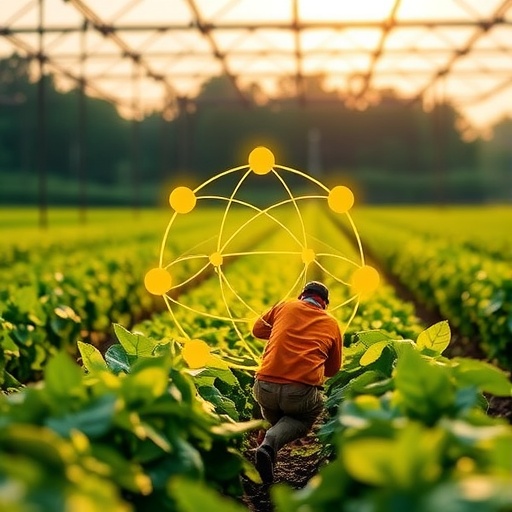In the face of escalating global food security challenges, with an estimated 2.3 billion people suffering from food insecurity, cutting-edge innovations in agricultural science are more vital than ever. Researchers from leading Chinese institutions—the University of Science and Technology of China (USTC), Tsinghua University, and Hefei University of Technology (HFUT)—have unveiled a transformative breakthrough in crop protection. This novel development leverages single-atom copper technology to forge a pesticide with unparalleled efficacy and environmental safety, poised to become a game-changer in the sustainable agriculture sector.
Conventional copper-based pesticides, such as the Bordeaux mixture introduced in 1885, have remained staples in combating plant diseases worldwide. However, their extensive use has led to significant environmental and agricultural drawbacks. Traditional formulations often cause toxic copper accumulation in soils, reaching concentrations as high as 10^3 mg/kg. This buildup not only threatens soil health and microbial biodiversity but also induces phytotoxicity, compromising crop vitality. The low atomic utilization efficiency of copper in these pesticides means that large quantities are required for effectiveness, intensifying ecological contamination risks.
The groundbreaking innovation by the research team centers on synthesizing a single-atom copper pesticide, symbolized as Cu_1/CaCO_3, which features copper atoms precisely anchored at the atomic scale onto a calcium carbonate support. This atomic dispersion is achieved via meticulous chemical precipitation methods that yield a stable, uniform Cu-O_4 coordination structure—a local molecular architecture verified by sophisticated microscopy and spectroscopy. This atomic-level engineering dramatically enhances the pesticide’s copper utilization efficiency, enabling potent antimicrobial action with remarkably diminished environmental impact.
Field evaluations underscore the Cu_1/CaCO_3 pesticide’s exceptional performance against rice bacterial blight caused by Pantoea ananatis, a notorious pathogen impeding global rice production. At a concentration of 1500 mg/L, this innovative formulation attained a disease control efficacy of 77.97%, rivaling and potentially surpassing many traditional pesticides. Crucially, prolonged application trials detected a twentyfold decrease in copper residue accumulation in soil compared to standard copper compounds, spotlighting the material’s minimal ecological footprint.
Biological safety assessments further establish the advantage of this single-atom pesticide. Unlike classical copper fungicides, which can induce phytotoxicity and non-target organism harm, the Cu_1/CaCO_3 formulation displayed excellent compatibility with plants and beneficial soil microbiota. Its selective toxicity manifests through targeted mechanisms: the copper atoms disrupt the protective lipid membranes of pathogenic bacteria and interfere with their respiratory chains, crippling energy generation processes. This mode of action not only ensures high antimicrobial effectiveness but also limits collateral damage to non-pathogenic organisms.
Fundamentally, the shift from nanoparticulate or bulk copper formulations to a single-atom paradigm represents a watershed moment in agrochemical development. The precise atomic dispersion addresses a critical inefficiency inherent to previous products by maximizing active site accessibility and minimizing copper wastage. This innovation taps into recent advances in materials science, where single-atom catalysts have revolutionized fields like energy conversion and catalysis, now effectively translated to agricultural chemistry.
The collaborative international effort, led by Professor Yuen Wu and Associate Researcher Kong Chen at the State Key Laboratory of Precision and Intelligent Chemistry, demonstrates the power of interdisciplinary research in tackling complex agricultural challenges. Partnering with experts from Tsinghua University and HFUT, the team harnessed high-resolution characterization tools such as aberration-corrected scanning transmission electron microscopy (AC-STEM) and X-ray absorption fine structure (XAFS) spectroscopy to validate the atomic structure and elucidate the material’s interaction pathways with biological targets.
Beyond rice, there is considerable potential to extend this single-atom copper pesticide technology to protect a broad spectrum of crops against bacterial and fungal pathogens, presenting a universal green strategy. This adaptability could reduce reliance on synthetic chemical pesticides prone to resistance development and environmental persistence, aligning with global initiatives towards sustainable agricultural intensification.
Looking forward, the study heralds a paradigm shift that could transform crop protection practices worldwide. By marrying nanoscale precision with agricultural applications, the Cu_1/CaCO_3 pesticide exemplifies how atomic-level manipulation can dramatically enhance efficacy while drastically lowering ecotoxicity risks. This approach may catalyze a new generation of environmentally benign pesticides, integral to securing food supply chains amid growing population pressure and climate uncertainties.
As Professor Wu summarized, “Our findings confirm that engineering pesticides at the atomic level unlocks untapped potential to safeguard crops while preserving ecosystems. It represents a bold step toward reconciling agricultural productivity with environmental stewardship.” This research paves the way for future innovations that leverage single-atom materials not only in protection but potentially also in nutrient delivery and soil remediation, driving holistic advances in sustainable agriculture.
In the spirit of translating fundamental materials science breakthroughs to real-world solutions, this single-atom copper pesticide could soon inspire regulatory acceptance and commercial development, ultimately benefiting farmers, consumers, and the planet. Its design and demonstrated success constitute a compelling model for how interdisciplinary collaboration can meet pressing global challenges through ingenious, atomically precise technologies.
Subject of Research: Development of a single-atom copper pesticide for sustainable plant disease control
Article Title: Single-Atom Copper Pesticide Cu_1/CaCO_3: A Breakthrough in Sustainable Crop Protection
Web References: DOI:10.1016/j.scib.2025.08.018
Image Credits: ©Science China Press
Keywords: single-atom catalyst, copper pesticide, sustainable agriculture, crop protection, Pantoea ananatis, plant disease control, Cu_1/CaCO_3, environmental safety, atomic dispersion, antimicrobial mechanism, materials science, nanotechnology
Tags: agricultural innovations for food securitybreakthroughs in agricultural sciencecutting-edge pesticide developmentefficacy of novel pesticidesenvironmental safety in pesticidesfood insecurity and agriculturephytotoxicity in crop protectionreducing toxic copper accumulationsingle-atom copper technologysoil health and microbial biodiversitysustainable agriculture solutionssustainable crop protection





